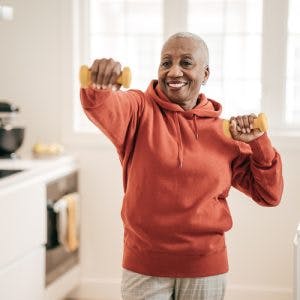When you move your arm, does your shoulder hike up? This is called a synergistic movement. During the early stages of stroke recovery, this type of movement is very common.
The term synergy is derived from a Greek term meaning “working together.” Synergistic movement, therefore, refers to when multiple muscles work together to perform a specific movement. Following a stroke, synergistic movements occur when you intend to perform a specific movement, but you end up performing other movements as well. For example, trying to move your affected elbow might result in hand and shoulder movements, too. While movement is a great sign during stroke recovery, synergistic movement is less than ideal.
If you’re frustrated by this phenomenon, don’t worry. This article will guide you through the cause of synergistic movement and how to overcome this unwanted movement pattern.
Use the links below to jump directly to any section of this article.
- What is synergistic movement?
- Types of synergistic movement after stroke
- Synergistic movement in early stroke recovery
- Unlinking synergistic movement
- How to overcome synergistic movement patterns
What is Synergistic Movement?
Synergistic movement refers to coordinated movements that occur when multiple muscle groups are activated simultaneously. As such, we are utilizing synergistic movements all the time. For example, in healthy individuals, four specific muscle synergies are used when walking. Each of these occurs at a different stage of one’s gait (walking) pattern and is essential for coordinating the movements required for walking.
However, most of the time, synergistic movements after a stroke refers not to healthy motor synergies, but rather to abnormal synergies which contribute to poor movement patterns. When a stroke affects the part of the brain that controls muscle movement, your brain cannot correctly send signals to your muscles. Thus, motor difficulties such as abnormal synergistic movement may occur.
For example, a stroke survivor displaying synergy may hike their shoulder when attempting to raise only their arm. This synergistic movement can lead to poor movement patterns and further complications such as chronic pain unless it is addressed.
Types of Synergistic Movement after Stroke
There are two main categories of synergistic movement after stroke, referred to as the flexor and extensor synergies.
In the arms, these synergies link the shoulder, elbow, wrist, and finger muscles together. This can cause difficulties with completing activities of daily living, such as dressing and eating, as the abnormal synergistic movement interferes with healthy muscle synergies typically used for these tasks.

In the arms, flexor synergy refers to:
- shoulder abduction (raising the arm to the side)
- elbow flexion
- supination (palm facing upwards)
- wrist and finger flexion
The extensor synergy of the arm involves many of the opposite movements, including:
- shoulder adduction (reaching inward)
- elbow extension
- pronation (palm facing downward)
- wrist extension and finger flexion (these postures may vary)
Flexor and extensor synergies are also seen in the legs. These synergies can interfere with walking and standing balance. Flexor and extensor synergies are only experienced on the affected side of the body, thus individuals may walk with a limp or other abnormal gait.

The flexor synergy of the leg includes:
- external rotation, abduction, and flexion of the hip
- knee flexion
- ankle dorsiflexion and eversion (foot pointed upwards and outward)
Conversely, the extensor synergy of the leg consists of:
- internal rotation, adduction, and extension of the hip
- knee extension
- ankle extension and inversion (foot pointed downward and inward)
While synergistic movement after stroke may pose many challenges, it can also signify the beginning of a survivor’s journey to recovery.
Synergistic Movement in the Early Stages of Stroke Recovery
Although synergistic movement might seem like a frustrating problem, it’s actually a sign of potential improvement. The Brunnstrom stages of stroke recovery explains this. There are seven stages in this framework:
- Stage 1: Flaccidity
- Stage 2: Spasticity appears
- Stage 3: Increased spasticity
- Stage 4: Decreased spasticity
- Stage 5: Complex movement returns
- Stage 6: Spasticity disappears
- Stage 7: Normal function returns
Depending on the severity of their stroke, survivors can start at any stroke recovery stage. Synergistic movement tends to display in the second stage of the Brunnstrom framework, along with spasticity (a condition that causes stiff, tight muscles). The first stage, flaccidity, occurs when there is zero innervation in the affected muscles — otherwise known as post-stroke paralysis.
When a survivor progresses from stage 1 to stage 2 of the Brunnstrom framework, movement begins to return to the affected muscles — specifically, synergistic movement returns. Although this unintentional movement pattern requires further rehabilitation, it is a sign of progress. It means the affected muscles are starting to “wake up” and the survivor can continue to work through the stages of recovery.
Synergistic movement persists until stage 5 of the Brunnstrom framework, where survivors regain the ability to perform more complex, coordinated movements.
Now, let’s discuss how to progress past synergistic movement to a fuller recovery after stroke.
Unlinking Synergistic Movement
When synergistic movement occurs, physical and occupational therapy can help retrain your brain to move your muscles smoothly – without making other unnecessary movements. The best way to retrain your brain is with consistent practice of stroke rehabilitation exercises.
Repetition is the best treatment for mobility issues after stroke. Whenever you consistently practice repetitive movements (referred to as massed practice), you reinforce the neural pathways in your brain responsible for that task. That’s why habits become second nature – the neural pathways have been strengthened through repetition. This process of creating and strengthening neural connections, referred to as neuroplasticity, is how the brain is able to rewire itself to recover after stroke.
When you practice arm exercises repetitively, you start to strengthen the neural connections that control your affected arm. However, it can be difficult to practice these exercises accurately when synergistic movement makes unintended muscles move, such as your shoulder hiking up.
This might cause you to worry about learning improper movement patterns. Next, we’ll discuss why you don’t need to worry about that when you try your best each time you exercise.
How to Overcome Synergistic Movement Patterns
Most therapists will agree that it is not ideal to practice rehab exercises incorrectly (i.e. with synergistic movement patterns), as it could reinforce these poor movement patterns.
However, when severe spasticity and synergistic movement prevent a stroke survivor from moving at all, it’s clear that any type of movement is better than no movement when you’re trying your best and focusing on good form every time.
As long as you are trying your best to use good form every time you exercise, you will continue to promote neuroplasticity and get better and better.
At this stage of recovery, you will get the most out of your exercises by doing them directly with your therapists because they can use manual therapy techniques to guide your limb(s) with proper form during each repetition. This will help to reinforce proper movement patterns rather than abnormal synergistic patterns.
Understanding Synergistic Movement After Stroke
Synergistic movements happen when you try to move one body part (like your arm) and end up moving multiple parts (like your arm, hand, and shoulder). Although this can be a frustrating pattern, it’s actually a possible sign of recovery as long as rehabilitation is being pursued.
You can minimize synergistic movement patterns by practicing therapeutic rehab exercises. Repetition of these movements helps rewire the brain and ‘separate’ your muscle movements. With consistent practice, you will work towards being able to perform accurate, coordinated movements.










